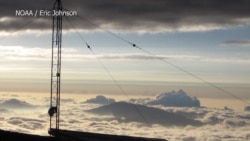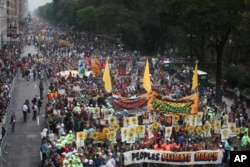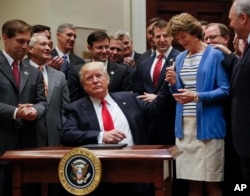If last weekend's protest march was about science, this weekend it's about people.
On Saturday, the People's Climate March takes place in Washington. Scientists, religious groups, advocates for low-income people of color, labor unions, anti-corporate activists and more plan to march down Pennsylvania Avenue and encircle the White House. They condemn President Donald Trump's support for fossil fuels and his disdain for the dangers of climate change.
The demonstration comes a week after the March for Science drew crowds of researchers and science enthusiasts to Washington and more than 600 locations worldwide. Marchers denounced policymakers who ignore the scientific consensus on climate change and other issues.
The back-to-back marches are an example of how an issue that once concerned a small group of researchers is now on the agenda for groups ranging from low-income people of color to major corporations.
Resistance
While the science march was nominally nonpartisan, this Saturday's is not.
The People's Climate March is about “making sure Trump's attacks on our families and our communities are resisted,” said the Sierra Club's Maura Cowley.
Trump's “America First” energy policy aims to tap abundant domestic coal, oil and natural gas resources by relaxing regulations that restrict their development.
“Renewed offshore energy production will reduce the cost of energy, create countless new jobs and make America more secure and far more energy independent,” Trump said Friday at a signing ceremony for his latest executive order promoting fossil fuel development.
Opponents say Trump's efforts to boost fossil fuel production threaten to raise greenhouse gas emissions at a time when the planet faces dangerous levels of warming.
Minorities hit first and worst
March organizers say the climate movement has expanded far beyond the usual environmental groups and their typically white members.
“There has been a challenge with diversity on the issue of environment and climate,” said Liz Havstad, executive director of the advocacy group the Hip Hop Caucus. “Part of it is a misconception that communities of color and low-income communities may not care as much about climate and environment because it may not feel as front-and-center as other issues. But that's a mistake.”
She noted that low-income minority communities are hit first and worst by the consequences of climate change.
“When Hurricane Katrina hit and we saw all in front of us what the impacts of a storm like that could be, and what it means for poor folks, poor people of color in terms of how our government responded, we knew we had to take on climate change as a major issue,” Havstad said.
Plus, she noted, the oil refineries, coal-fired power plants and other facilities generating the pollution that causes climate change are often located where low-income people of color live.
Growing support
The list of nearly 1,000 groups joining Saturday's march reads like a roll call of local, state and national progressive politics. But it's not just advocates, noted Union of Concerned Scientists President Ken Kimmell.
“There are a lot of businesses that are now part of this mix,” he said, “either because they're companies that care about the fate of the planet and they're buying a lot of renewable energy and becoming efficient, or they're clean-energy companies, who are employing hundreds of thousands of people in the solar and wind industry.”
The public is increasingly behind the march's aims. According to recent polls, two-thirds to three-quarters of Americans are concerned about climate change, and two-thirds say humans are responsible.
Kimmell says the one key group missing from the coalition wanting action on climate is elected Republicans in Washington.
“I don't want to say this is just a partisan issue,” he added. “When you get out of the Beltway, people are rolling up their sleeves and dealing with this issue.” He pointed to Republican state governors who have supported clean energy. “But within Washington, there's no doubt there's an unfortunate absence of leadership.”
The 2014 People's Climate March drew hundreds of thousands to New York City. This year's march is expected to include author and former Vice President Al Gore, movie star Leonardo DiCaprio and businessman Richard Branson.
The forecast calls for temperatures near 32 degrees Celsius, more typical for July than April in Washington.











